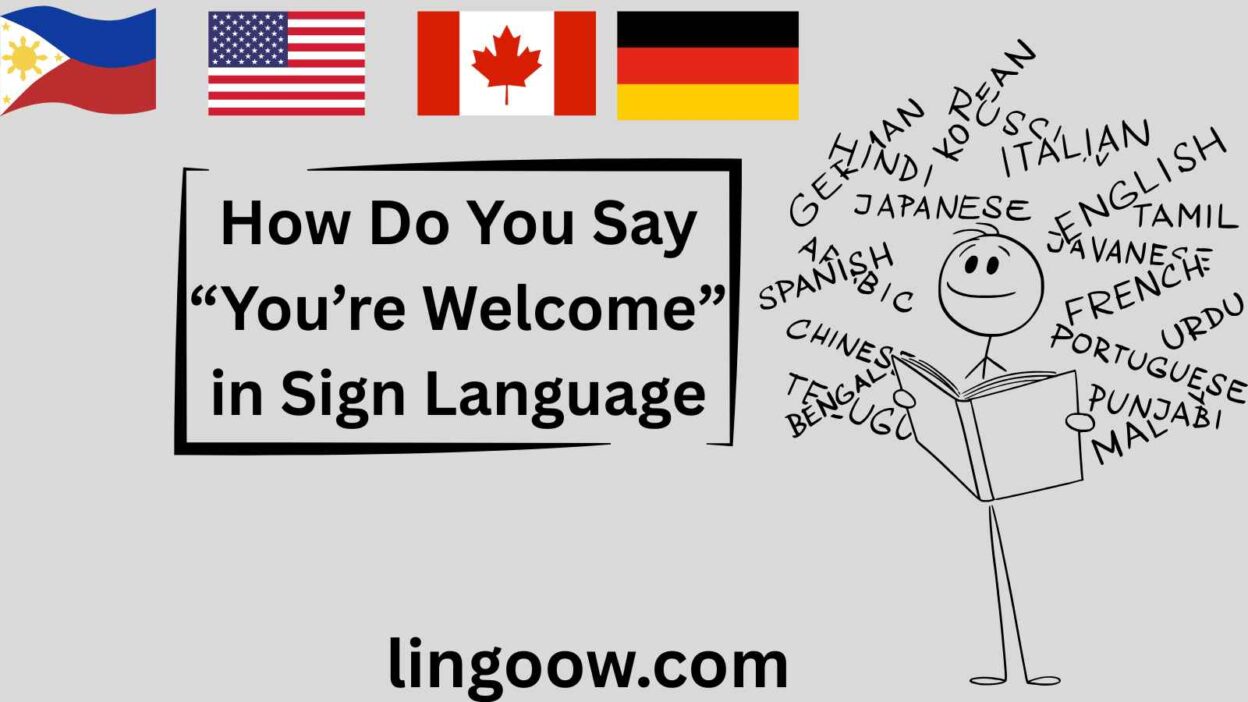A few years ago, I witnessed something deeply beautiful at a café.
A young barista handed a cup of coffee to a deaf customer who had just signed thank you.
The barista smiled warmly and responded — not with words, but by moving her hand gracefully from her chin outward, in a simple, fluid motion.
It was the phrase “You’re welcome” in American Sign Language (ASL).
That moment captured something profoundly human — the ability to connect beyond words, across cultures and sound. “You’re welcome” is more than just a polite reply; it’s a small act of kindness that completes the circle of gratitude. Whether spoken, written, or signed, this phrase bridges people in every corner of the world.
Let’s explore how “You’re welcome” is expressed in sign language and in different languages and cultures worldwide, revealing how gratitude connects us all.
🖐️ You’re Welcome in Sign Language
In American Sign Language (ASL), “You’re welcome” can be expressed in two main ways:
- Traditional form: Place your flat hand near your chin and move it outward and slightly downward, toward the person you’re thanking — as if giving something back.
- Modern form: Many signers simply use the sign for “thank you” in return, since the sentiment is understood naturally within the context of gratitude.
In British Sign Language (BSL) and Australian Sign Language (Auslan), gestures may vary, but the essence remains — an open-handed movement conveying warmth and acknowledgment.
What’s beautiful about sign language is its universality in emotion. You don’t just say the words — you show them. Your face, your eyes, and your movement all become part of the language of kindness.
🌐 Table: “You’re Welcome” in Different Languages
| Language | Phrase | Cultural or Linguistic Insight |
|---|---|---|
| English | You’re welcome | A polite closure to “thank you,” often used with warmth or humility. |
| French | De rien | Literally “of nothing,” implying “it’s nothing” — a modest response. |
| Spanish | De nada | Means “it’s nothing,” reflecting humility and generosity. |
| Italian | Prego | Also used to say “please” — shows openness and hospitality. |
| German | Bitte schön | Means “you’re welcome” or “my pleasure,” tied to politeness. |
| Portuguese | De nada | Similar to Spanish, expressing modesty. |
| Japanese | Dō itashimashite (どういたしまして) | A formal and respectful reply; politeness is central in Japanese culture. |
| Mandarin Chinese | 不客气 (Bù kèqì) | Means “don’t be polite,” suggesting friendship and informality. |
| Hindi | आपका स्वागत है (Aapka swagat hai) | Literally “you are welcome” — deeply respectful and gracious. |
| Arabic | على الرحب والسعة (ʿAla ar-raḥbi wa as-saʿa) | Means “with pleasure and spaciousness” — a warm Arab expression of generosity. |
| Swahili | Karibu | Also means “welcome” (as in greeting), symbolizing hospitality in East Africa. |
| Zulu | Wamukelekile | Expresses deep warmth and acceptance. |
| Yoruba | Kaabo | Means “welcome,” often used both as greeting and response of hospitality. |
| Hawaiian | ʻAʻole pilikia | Means “no trouble” — a calm, friendly spirit of aloha. |
| Maori | Kei te pai | Means “it’s okay” — reflects humility and peace. |
🇪🇺 European Languages: Grace and Courtesy in Every Word
In Europe, the words for “you’re welcome” often reflect modesty and humility.
In French (“De rien”) and Spanish (“De nada”), both literally mean “of nothing.” This expresses that your act of kindness was no burden — a beautiful reflection of social grace.
Italian’s “Prego” carries an added layer. It’s used not only as “you’re welcome” but also as “please,” embodying a culture of generosity and hospitality.
In Germany, “Bitte schön” and “Gern geschehen” (literally, “gladly happened”) convey warmth and sincerity. Gratitude here is not just etiquette; it’s a reflection of respect and community values.
🇦🇸 Asian Languages: Respect, Honor, and Harmony
Across Asia, expressions of “you’re welcome” often emphasize respect and social harmony.
In Japan, “Dō itashimashite” is formal, careful, and polite — a way of maintaining harmony (wa).
In China, “Bù kèqì” literally means “don’t be so polite,” showing closeness and equality.
In Hindi, “Aapka swagat hai” means “you are welcome,” reflecting India’s deep-rooted culture of hospitality.
In Arabic, across 20+ nations, you might hear variations like “ʿAla ar-raḥbi wa as-saʿa” or “Ahlan wa sahlan”, each reflecting generosity — one of the central virtues in Arab culture.
In Korean, “천만에요” (Cheonmaneyo) means “not at all,” expressing humility. Across Asian languages, you’re welcome is less about pride and more about preserving harmony and gratitude.
🌍 African Languages: The Language of Community and Kindness
In Africa, expressions of gratitude and welcome are often intertwined with community spirit and hospitality.
In Swahili, spoken across East Africa, “Karibu” means both “you’re welcome” and “welcome (to my home).” It’s an open invitation — a reflection of generosity deeply embedded in African culture.
In Zulu, “Wamukelekile” embodies warmth and belonging.
In Yoruba, “Kaabo” (meaning “welcome”) shows acceptance and openness.
Across Africa’s 20+ linguistic landscapes — from Hausa to Amharic to Xhosa — the idea of being “welcome” often connects to community, home, and unity.
🏝️ Indigenous & Island Languages: Spirit, Connection, and Peace
Indigenous and island languages express you’re welcome as an invitation of the spirit — not just politeness.
In Hawaiian, “ʻAʻole pilikia” means “no problem,” spoken with the calm energy of the aloha spirit.
In Māori, “Kei te pai” means “it’s okay” or “no problem,” reflecting humility and peace.
In Cherokee, expressions of gratitude and welcome often connect to the earth and community, emphasizing harmony.
In Samoan, “Leai se mea” (no worries) reflects the joyful, communal nature of island life.
These phrases remind us that in many indigenous traditions, hospitality is sacred.
💫 Cultural Insights: The Evolution of “You’re Welcome”
Historically, gratitude and reciprocity have existed long before formal language. In ancient cultures, gift exchanges, shared meals, or rituals were acts of mutual appreciation — no words needed.
As languages evolved, phrases like “you’re welcome” became the verbal equivalent of sharing a smile or an open hand.
In many societies, the word also carries religious or moral undertones — an acknowledgment that kindness is part of a larger human duty.
Today, even in digital communication, emojis like 🤗 or 🙏 have become our new universal gestures of “you’re welcome” — bridging cultures once again.
🗣️ Proverbs About Gratitude and Welcome
- French: “La gratitude est la mémoire du cœur.” (Gratitude is the memory of the heart.)
- Swahili: “Shukrani ni ufunguo wa baraka.” (Gratitude is the key to blessings.)
- Chinese: “感恩之心,常存不忘。” (A grateful heart never forgets.)
- Arabic: “من لا يشكر الناس لا يشكر الله.” (He who does not thank people does not thank God.)
- English: “Kindness is a language the deaf can hear and the blind can see.” — Mark Twain
These sayings remind us that gratitude — and welcoming it — transcends borders, religions, and time.
❓ FAQs
Q: Why do many languages use phrases like “It’s nothing” for “You’re welcome”?
A: Because humility is a universal virtue. It shows that kindness was given freely, without expecting reward.
Q: What’s the oldest known phrase for “You’re welcome”?
A: Ancient Latin and Greek expressions of hospitality, such as “Gratus es” (you are pleasing), evolved into today’s European forms.
Q: Do all cultures say “You’re welcome”?
A: Not exactly — some cultures express gratitude through actions or smiles rather than words. In sign language, expression and context often replace formal replies.
🌎 Conclusion: The Universal Language of Kindness
Whether spoken aloud, whispered softly, or expressed with a gentle movement of the hand, “You’re welcome” is a global reminder that kindness connects us all.
In every corner of the world — from Parisian cafés to African villages to quiet sign language exchanges — gratitude flows both ways.
So next time someone thanks you, pause, smile, and reply in your own way —
because every “you’re welcome” is a ripple of warmth that travels farther than words.




